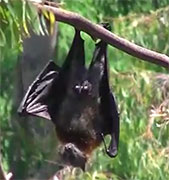- Skip Storing This Everyday Product in the Fridge Door
- Green Tea + B3 Pairing May Boost Brain Health
- Navigating Your Midlife Crisis: Embracing New Possibilities
- City Raccoons Showing Signs of Domestication
- Mapping the Exposome: Science Broadens Focus to Environmental Disease Triggers
- One Week Less on Social Media Linked to Better Mental Health
- Your Brain Changes in Stages as You Age, Study Finds
- Some Suicide Victims Show No Typical Warning Signs, Study Finds
- ByHeart Formula Faces Lawsuits After Babies Sickened With Botulism
- Switch to Vegan Diet Could Cut Your Greenhouse Gas Emissions in Half
Scientists Tally Viruses Living in Mammals

TUESDAY, Sept. 3At a minimum, 320,000 viruses exist among mammals, according to a new study. Identifying these infectious organisms could help alleviate disease outbreaks through early detection — but compiling evidence on these viruses would cost up to $6.3 billion, researchers say.
However, this hefty price tag is just a small fraction of the economic toll that is caused by major pandemics, like SARS, according to researchers at the Center for Infection and Immunity (CII) at Columbia University’s Mailman School of Public Health.
Prevention of viral outbreaks is critical because antiviral medications are often difficult to develop, the authors pointed out in a school news release.
“For decades, we’ve faced the threat of future pandemics without knowing how many viruses are lurking in the environment, in wildlife, waiting to emerge. Finally we have a breakthrough — there aren’t millions of unknown virus, just a few hundred thousand, and given the technology we have it’s possible that in my lifetime, we’ll know the identity of every unknown virus on the planet,” study corresponding author, Peter Daszak, president of EcoHealth Alliance, said in the news release.
Although 70 percent of new viral diseases, such as HIV/AIDS, West Nile and SARS, are infections that cross from animals into humans (known as zoonoses), the researchers say their estimate is the first to project the number of viruses among any wildlife species.
“Historically, our whole approach to discovery has been altogether too random,” lead study author Simon Anthony, a CII scientist, said in the news release. “What we currently know about viruses is very much biased towards those that have already spilled over into humans or animals and emerged as diseases. But the pool of all viruses in wildlife, including many potential threats to humans, is actually much deeper.”
For the study, published Sept. 3 in the journal mBio, a multidisciplinary team of researchers examined the flying fox, a type of bat that lives in the jungles of Bangladesh. Flying foxes, the largest flying mammal with a wingspan of up to six feet, are the source of several outbreaks of Nipah virus.
Researchers collected nearly 1,900 biological samples from the bats before releasing them back into the wild, and identified 55 viruses in nine viral families. Only five viruses were previously known. Among the new discoveries were 10 related to Nipah virus.
The study authors also estimated that there were another three rare viruses, which were unaccounted for in the samples collected. After increasing the total estimate of viruses in the flying fox to 58, the researchers extrapolated their data to include all 5,486 known mammals. They calculated that there are at least 320,000 viruses.
Based on the cost of collecting their data on the flying fox, the researchers concluded that the cost to observe, sample and identify viruses in all mammals would reach $6.3 billion. By excluding rare viruses and limiting the exercise to 85 percent of all viruses among mammals, the cost would be reduced to $1.4 billion.
“By contrast, the economic impact of the SARS pandemic is calculated to be $16 billion. We’re not saying that this undertaking would prevent another outbreak like SARS. Nonetheless, what we learn from exploring global viral diversity could mitigate outbreaks by facilitating better surveillance and rapid diagnostic testing,” Anthony said. “If we know what’s out there, we’ll be a lot better prepared when a virus jumps over into a human population,” he noted in the news release.
Senior study author, Dr. W. Ian Lipkin, director of CII, added: “Our goal is to provide the viral intelligence needed for the global public health community to anticipate and respond to the continuous challenge of emerging infectious diseases.”
More information
The U.S. National Library of Medicine has more about viral infections.
Source: HealthDay
Copyright © 2025 HealthDay. All rights reserved.










